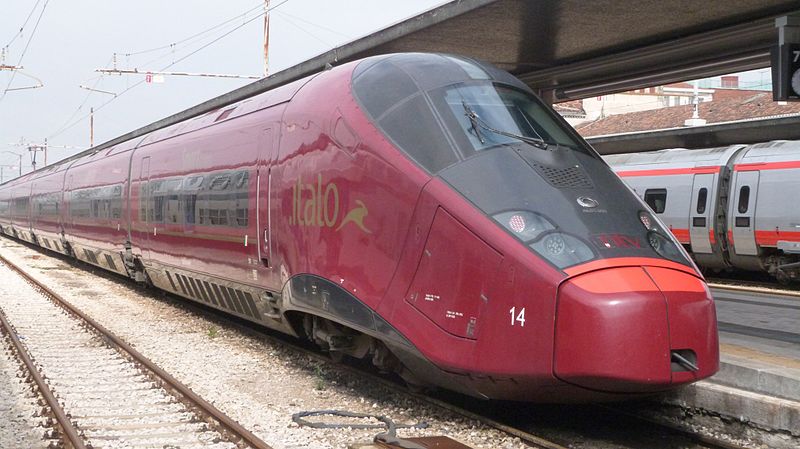Alitalia, Italy’s national airline, flew for the last time on Thursday. Analysts say a big part of why it went bankrupt is because it failed to expand internationally and was out competed on domestic routes by Italy’s exceptional high-speed rail system.
From CNN:
Figures released in 2019 by Italy state railway company Ferrovie dello Stato show that the number of passengers taking the train on the country’s main business route, between Rome and Milan, has almost quadrupled in a decade, from 1 million in 2008 to 3.6 million by 2018.
Over two thirds of people traveling between the two cities now takes the train. It’s a remarkable endorsement of Italy’s high-speed rail network, which debuted in 2008.Traveling those near-400 miles between Milan and Rome takes as little as 2 hours and 59 minutes. And, of course, the train stations are in the city center, and there’s no need to turn up long before your train — the doors close two minutes before departure.
Contrast that to a minimum half-hour drive to Rome’s Fiumicino, checking in 90 minutes before departure, an hour in the air and then landing outside Milan — Linate airport, the closest, is about 20 minutes’ drive into town — and it’s obvious why people are opting for the train.
This is a pattern one sees across the world. The Japanese high-speed rail system wiped out flights between Tokyo, Osaka and other cities. And domestic flights in France, Germany, and elsewhere were eliminated or greatly reduced.
A single Boeing 737 burns 750 gallons of fuel an hour. Multiply that by all the planes flying between Los Angeles, Burbank, San Jose, Oakland, Vegas, and San Francisco, every day, 365 days a year. Add that to the car trips high-speed rail could replace and that’s a lot of loot oil companies stand to lose if a real, electrified, high-speed train is completed in California.
California’s HSR system, like its counterparts in France, Japan, China, Italy, and everywhere else in the world, won't need oil. However, they do need overhead wire to get juice from renewable power stations to the train’s motors. But politicians in the state leadership, notably State Assembly's Speaker Anthony Rendon and Transportation Committee Chair Laura Friedman, are opposed to running that wire. Battery powered trains, their proposed alternative to electrification, simply can't do the job: they are way too slow, have too short a range, and just won't cut it for reasons that come down to fundamental physics. They've also pushed for diesel locomotives, which the state runs presently and, of course, still consume diesel oil.
Only overhead, electrified high-speed rail, will get California to a place where it will consume a lot less oil for intercity transportation. That's why Caltrain is electrifying its mainline between San Francisco and San Jose.
Maybe don’t gut High Speed Rail next time so we aren’t dependent on oil for our economy
— GottPlotts (@yarrowdad) October 6, 2021
Meanwhile, the California Coast is again soaked with spilled oil. But Rendon and Friedman, as seen in the tweet above, seem utterly oblivious to the connection. On Friday, they reiterated their obstruction in a letter urging Governor Gavin Newsom to build high-speed rail that isn’t high-speed rail at all, by withholding funds for electrification and placing other brakes in the way of planned electrification. Rendon and Friedmans latest letter, as an earlier letter did, also urges the use of battery-powered high-speed trains that don’t exist and aren’t possible.
I look forward to continuing to work with Governor Newsom to deliver a functional high-speed rail system to Californians. pic.twitter.com/1QtzoC46Dt
— Anthony Rendon (@RendonAD62) October 15, 2021
It’s, shall we say, strange that their opposition to high-speed rail in California is laser focused on stopping the electrification.
Nearly every American politician, Republican and Democrat, at all levels of government, take big contributions, directly or indirectly, from Chevron, the Western States Petroleum Association, and other proxies of big oil. The opponents of California HSR are no exception. And it’s hardly news to point out that petroleum companies have a history of fighting transit (and sowing doubt over global warming).
As reported by Cal Matters in 2018: “Assembly Speaker Anthony Rendon said that despite campaign support from Big Oil, Democrats have passed environmental measures that oil companies opposed—including legislation to curb offshore drilling and expand renewable energy.”
“Does it influence individual members? I’m not sure,” Rendon told Cal Matters. “But as a body, I think we have a good record of standing up to oil.”
Unfortunately, blocking electrification of California's rail project isn't what "standing up to oil" looks like.






